Effective communication is crucial in any professional setting, whether you’re participating in a meeting, conversing with your colleagues, or attending a presentation.
However, when communication comes to a halt or a misunderstanding emerges, navigating through communication barriers can be quite challenging.
These barriers often obstruct the smooth flow of information, leading to misunderstandings that waste valuable time and resources.
Therefore, it is vital to identify these barriers and find ways to minimize their impact.
In this article, we’ll explore common communication barriers across different industries and provide practical solutions to bridge these gaps.
So, let’s dive in and see how you can enhance communication within your team!

What is a communication barrier?
In essence, any problem or obstacle that gets in the way of the communication process qualifies as a communication barrier.
The truth is, rarely any communication situation is devoid of barriers, as they can happen at any stage of the interaction.
That’s why you should become familiar with specific causes of communication barriers in the workplace and learn how to overcome them.
Although classifications vary, the most common communication barriers include:
- Physical barriers,
- Perceptual barriers,
- Emotional barriers,
- Cultural barriers,
- Language barriers,
- Gender barriers,
- Interpersonal barriers, and
- Organizational barriers.
As each of the above barriers has its own challenges, just knowing the classification won’t be enough to optimize workplace communication.
As we’ve mentioned, you’re bound to run into obstacles in professional communication.
But this doesn’t mean that barriers to communication doom all business interactions to failure. By learning more about communication barriers, you’ll get a clear overview of how they impact conversation and understand which preventative measures to take.
Physical barriers to effective team communication + solutions
Physical barriers to communication represent the various environmental and natural conditions acting as barriers between the senders and receivers of information.

These physical barriers include challenges related to:
- Time and distance,
- Personal space,
- Workplace design,
- Work environment, and
- Background noise.
Physical barrier #1: Time and distance
The barriers related to time and distance typically affect remote teams whose members work from home.
Remote teammates do not work in the same office or even at the same time. Instead, they may operate on a different continent and time zone. This makes real-time communication difficult and in-person communication inconvenient or near impossible — unless one teammate is willing to accommodate the other, work at night, or fly across the globe regularly.
Embracing asynchronous communication can help prevent time and distance communication barriers in the workplace.
Consider using specialized apps, such as:
- A team communication app: It allows for direct messaging, audio/video calls, topic-based channels, and scheduling messages.
- A project management tool: You can use it to communicate project details.
- A time tracker: You can use it to indicate and track everyone’s work hours.
- A time converter app: It helps you see everyone’s time zones and organize meetings accordingly.
By taking advantage of the above tools, you’ll be able to make in-person work more efficient and address the challenges of remote and hybrid work.
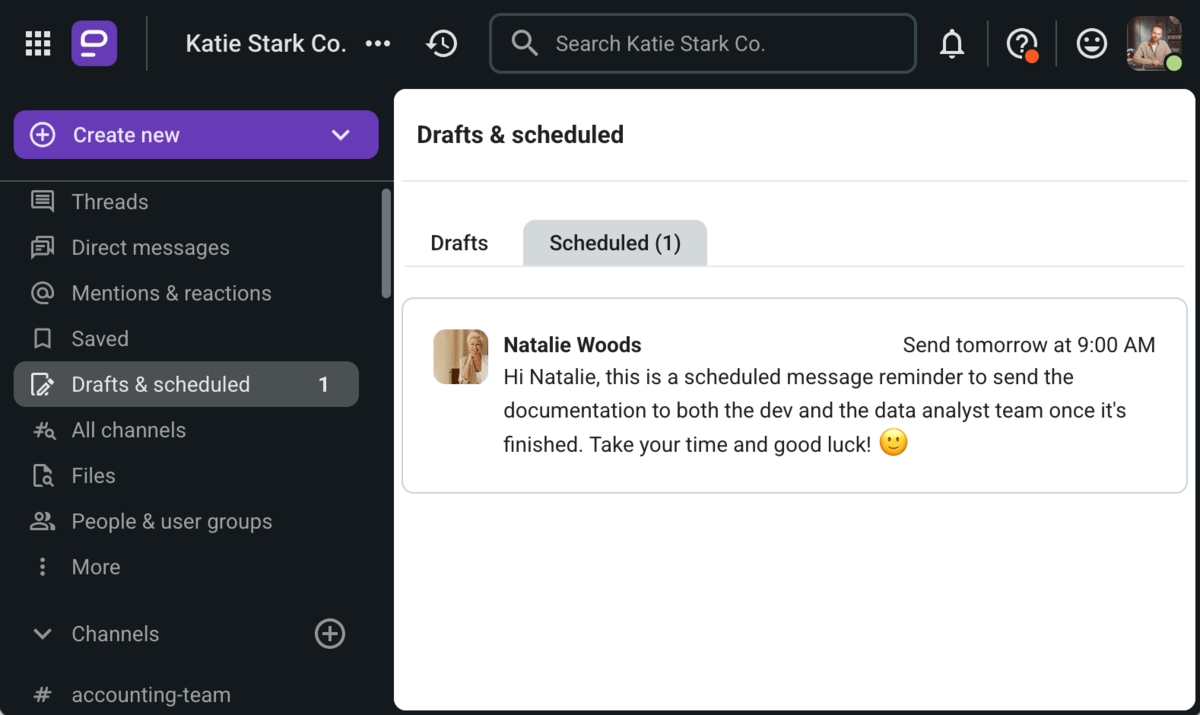
Streamline team communication with Pumble
Physical barrier #2: Personal space
In verbal communication (or face-to-face communication), personal space plays a crucial role.
Namely, the distance that applies only to in-person communication may act as a facilitator to good communication or as a barrier to effective communication, depending on whether it’s adequately interpreted and arranged.
We can recognize 4 types of distance between in-person communicators:
- Intimate space: The distance between the communicators is less than 18 inches (0.45 meters). It’s usually reserved for close relationships, such as between a parent and child or between partners.
- Personal space: The distance between communicators is 2–3 feet (0.6–0.9 meters). It’s typically associated with friends and peer groups.
- Official space: The distance between communicators is 4–5 feet (1.2–1.5 meters), depending on the type of information transmitted. This type of space is associated with official situations, such as most communication situations at work.
- Public space: The distance between communicators is over 10 feet (3 meters). Public space is associated with speakers and listeners in public situations, like speaking events.
Reducing these space requirements may lead to awkward or embarrassing situations.
But, this depends on a person’s culture.
Namely, people from the US and Northern Europe dislike having their personal space violated.
On the other hand, people from South American countries and the Middle East belong to so-called “contact cultures.” This means they’re generally more comfortable with people coming closer, even if they’re not close friends.
This makes space not only a physical barrier to effective communication but often a cultural one as well.
In a professional setting, you should always maintain a moderate distance from the people you are speaking with.
When it comes to public speeches in smaller spaces, consider organizing a virtual meeting instead.

Hold effective virtual meetings with Pumble
🎓 Pumble Pro Tip
To learn how to better run both in-person and virtual meetings, check out this blog post:
Physical barrier #3: Workplace design
Workplace design can affect communication effectiveness in the workplace.
For example, the seating arrangements can facilitate effective communication — when team members who need to communicate and collaborate daily are seated at connected desks.
But, the seating arrangement can also become a barrier to communication, primarily when it isn’t addressed promptly.
If multiple employees are having issues with a cubicle-style office, an open office plan can go a long way in fixing the issue.
It’s likely that, after swapping out separate offices and cubicles for open tables, it will become much easier to communicate in person.
But, in companies with a remote or hybrid model, reaching someone in person isn’t always possible.
In that case, you can use threads in your digital HQ to keep all team members posted and on top of the latest developments, mirroring the benefits of an open space concept.
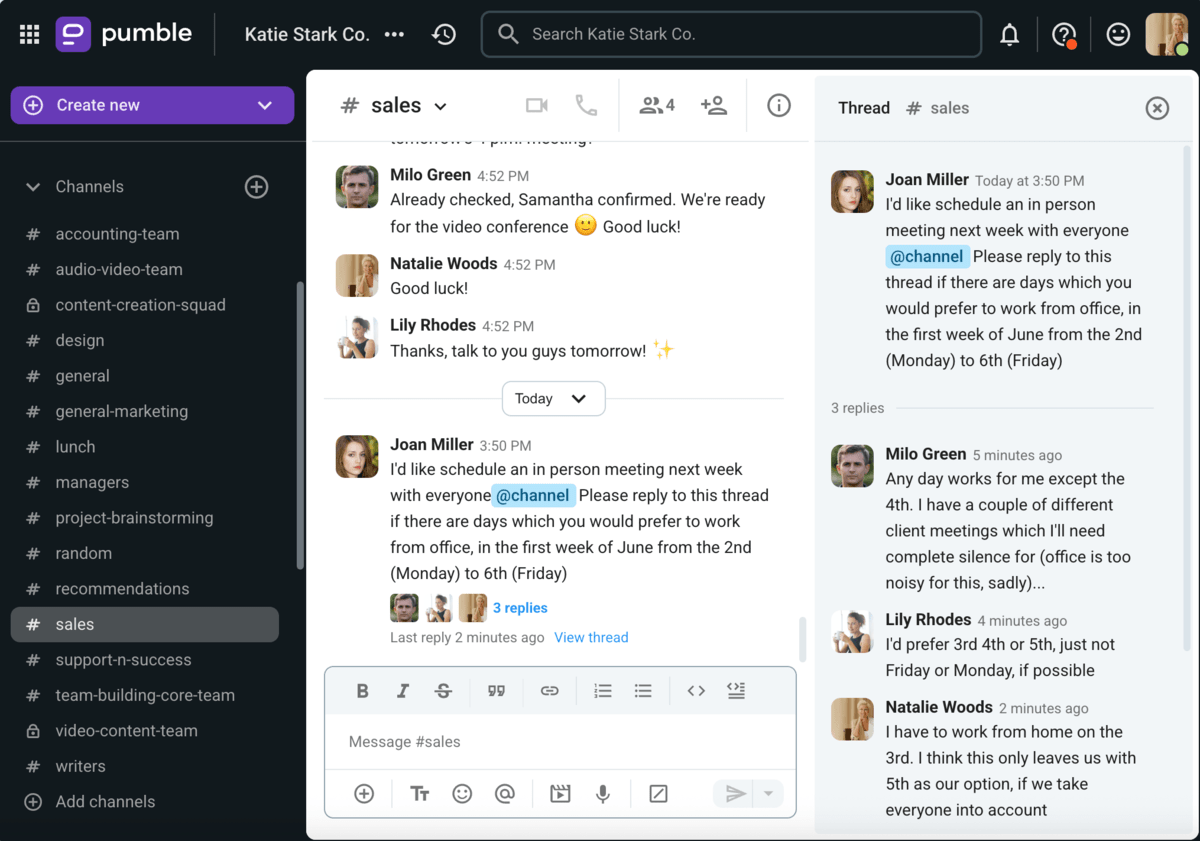
Physical barrier #4: Work environment
The chief element of a work environment that may hinder effective communication is comfort — or, more precisely, the potential lack of it.
Namely, if the company or home office is too hot or cold, people may not be able to fully focus on the information being communicated as the overall productivity drops. The same applies if the desks and chairs are too low or high or the office lighting is too bright or dim.
While you can’t always completely change your work environment, small tweaks can make your time in the office more enjoyable.
The best solutions here are to either adapt to what you can’t adjust, or organize an informal meeting with your colleagues to reach a compromise.
Physical barrier #5: Background noise
Noise is a common barrier to communication in the workplace.
Background noise can stem from:
- Colleagues talking nearby (often experienced by people who work in an office),
- Family members, roommates, or partners talking nearby (often experienced by people who work from home),
- Copy machines, kitchen noise, and other inside noises, and
- Outside noises from thunderstorms, traffic, or lawn equipment.
While some people can tune out and ignore the above distractions, most struggle to maintain their cognitive performance when exposed to loud intermittent noises.
Interestingly, introverts may have more problems focusing in noisy environments. A study from a research center in Glasgow examined the effect of background noise on both extroverts and introverts.
Although both groups performed poorly when background noise was present, the noise distractions significantly impacted the introverted participants. Since introverts are more sensitive to external stimuli, it’s unsurprising that loud environments prevent them from doing their best work.
So, the extent to which noises prevent us from focusing on our tasks may be down to our personality type.
To combat the negative effects of background noise, you could research the best ways to manage background noise.
Perhaps you’ll find that noise-canceling headphones are a great all-encompassing solution. Or, maybe that playing a noise generator app via regular headphones blocks most noise.
If the problem is noisy colleagues, talk to them, and try to find a suitable noise-reducing solution together.
Perceptual barriers to effective team communication + solutions
Perceptual barriers to communication represent the mental blocks people may have that influence their perceptions about specific people, topics, or events.

These perceptions form intra-personal barriers that affect how people send, receive, or interpret messages in conversations.
Perceptual barriers to effective communication include perceptual filters but also nonverbal language.
Perceptual barrier #1: Perceptual filters
Perceptual filters to effective communication include our:
- Thoughts,
- Cognitive biases,
- Assumptions,
- Preferences,
- Values, and
- Attitudes.
Unfortunately, these “filters” may lead to misunderstandings, stereotyping, and assumptions in communication. Such “filters” often make us closed-minded to opinions that are different from our own or ideas that go beyond what we consider “usual,” “expected,” or “normal.”
However, just because you perceive someone in a certain way doesn’t mean your perceptions hold true in reality.
Before declaring that you know exactly what someone thinks or feels, gaining all the relevant information is essential. This requires a certain level of flexibility, which can be hard when we refuse to question our own beliefs.
In the book Big Ideas: Putting the Zest Into Creativity & Innovation at Work, Jonne Cesarini touches on perceptual position. The author defines them as the outlooks we use as starting positions when thinking about specific topics and circumstances.
Cesarini also goes on to describe 4 perceptual positions:
- The “I” position: We base our worldview on our past experiences, assumptions, and beliefs.
- The “You” position: We step into someone else’s shoes and try to understand where they’re coming from.
- The “They” position: We detach ourselves from our emotions and the feelings of everyone involved in the situation. The goal is to become an impartial observer who comes in from a factual standpoint.
- The “We” position: We consider the bigger picture and adopt the perspective of a larger entity, such as a company or similar institution.
When we make a conscious effort to leave the “I” position and change our outlook, we can:
- Identify the shortcomings in our perspective,
- Get a clearer understanding of the people around us,
- Participate in more win-win situations,
- Learn how to overcome communication barriers, and
- Become more flexible and creative.
Of course, this is only possible if we’re willing to show up in our personal and professional lives with more empathy.
Perceptual barrier #2: Nonverbal language
Nonverbal facial expressions, triggers, and cues represent the body language people emit while communicating.
This body language may be connected with the intended meaning of the messages the communicator is trying to convey. But, it may also be intentionally or unintentionally misleading.
In line with that, people may perceive the nonverbal language of their fellow communicators correctly, or they might misinterpret it.
Observing nonverbal language can help you decide whether someone is lying, trying to conceal information, or mislead you.
But, it shouldn’t be the sole reason you decide to distrust someone.
So, don’t just look for disparities between people’s words and facial expressions.
Instead, always focus on what they are saying first. Don’t be shy to ask more questions if you cannot decide whether someone’s words match your perception of their nonverbal language.
These questions should be specific open-ended questions and direct “Yes/No” questions a person cannot evade.
The more questions you ask, the closer you will be to discovering what you want.
🎓 Pumble Pro Tip
To learn how to ask better questions at work, read this blog post:
Emotional barriers to effective team communication + solutions
Emotional barriers to communication represent the emotions that may hold you back from communicating what you want to your teammates.

These emotions might also stop you from listening to others attentively and accepting their point of view.
The key emotional barriers include:
- Anger,
- Pride, and
- Anxiety.
Emotional barrier #1: Anger
Anger is an emotional barrier to communication that affects how your brain processes information.
Because of anger, you are less likely to be logical in discussions.
Moreover, you are less likely to contribute productively to solving problems — and more likely to oppose other people’s ideas.
The people you are projecting your anger to will usually become defensive, scared, or hurt.
As a result, people may hesitate to contact you in case of an emergency — even if you objectively are the best person to solve the problem.
Emotional barriers to communication can be detrimental to team collaboration. When those in leadership positions don’t know how to manage their anger, teamwork suffers the brunt of this emotion.
To handle anger while communicating, try removing yourself from the problematic situation until you can manage and respond to it appropriately.
Preferably, you should do this before you snap at someone. Then, only once you’ve calmed yourself and collected your thoughts, address the matter again.
This time, think clearly about what you want to say before you say it, and refrain from making potentially hurtful comments.
Emotional barrier #2: Pride
Pride is an emotional barrier that inhibits healthy communication in several ways.
For one, pride as an emotion implies you take pride in what you say and do. When this feeling gets the better of you, you might talk more than you listen — and active listening is an essential skill of effective communicators.
As a result, teammates become wary of inviting you to brainstorming sessions — because your idea always needs to be the best one, or else you become difficult to work with.
Unfortunately, pride could severely impede successful teamwork and collaboration.
It’s arguably one of the most challenging communication barriers to overcome personally, because it always leads people to believe they’re in the right. However, it’s possible to take a step back and cool off, which quickly leads to the realization that no opinion is infallible.
If you struggle with pride, work on accepting that your statements may not always be perfect — or even correct. Don’t be afraid to admit to your mistakes instead of investing all your efforts into persuading others that you are not at fault, as this only wastes your time and energy.
If you have a particular emotional insecurity, don’t try to compensate for it with a false sense of superiority. Instead, identify the cause of your insecurities and try to address them.
Thanks to these efforts, people will feel more at ease when communicating with you, and your team will be more productive.
Emotional barrier #3: Anxiety
Anxiety is another emotional barrier to effective communication that can diminish the efficacy of your communication skills.
This emotion prevents you from becoming an effective communicator by eating away at your concentration. Instead of paying attention to others, you become increasingly preoccupied with what you want to say.
Moreover, anxiety may push you to avoid certain social situations and save yourself from embarrassment or difficult conversations, even in a professional setting.
Anxiety can generate persistent fear and worry and stop us from putting our best foot forward in the workplace.
Overcoming problems with anxiety is easier said than done, but there are ways you can try to keep the fear and worry at bay.
First, you could look into relaxation exercises and see whether meditation or breathwork can help you cope with stressful situations.
Also, try to consider why you feel anxious under certain circumstances — weigh down your reasons and decide whether they are worth the worries.
Finally, make sure to consult a medical professional for specialized advice if you suspect you have a more generalized anxiety problem.
🎓 Pumble Pro Tip
For a more detailed look into the connection between emotions and work, check out our article:
Cultural barriers to effective team communication
According to Joynt & Warner (1996), culture is “the pattern of taken-for-granted assumptions about how a given collection of people should think, act, and feel as they go about their daily affairs.”
In line with this definition, cultural barriers to communication represent the different culture-related behavior patterns that may arise as obstacles to well-balanced communication among teammates.

These culture-related behavior patterns may revolve around:
- Language,
- Nonverbal language, and
- Cultural norms, beliefs, and values.
They may also manifest as:
- Stereotypes or
- Status-based self-importance.
Cultural barrier #1: Language
Language barriers to communication can be detrimental, especially for teams across the globe. After all, it’s not uncommon to find people with different native languages in remote-first organizations.
For all their benefits, work-from-anywhere initiatives bring a unique set of drawbacks because if you don’t understand your teammates and they don’t understand you, communication breaks down.
The top solution for overcoming the communication barrier of different languages is to:
- Identify the language the entire team is comfortable using,
- Define it as the official team language, and
- Ensure all official correspondence between team members is handled in the selected language.
Cultural barrier #2: Nonverbal language
We already discussed nonverbal language when addressing the perceptual barriers to effective communication.
However, nonverbal language can also be connected with the speaker’s culture. The same gestures or facial expressions can have different meanings in different cultures.
In such cases, we regard nonverbal language as a crucial culture-based communication barrier.
The best way to avoid miscommunication and misunderstandings caused by these cultural differences is to learn about the nonverbal communication patterns of your teammates.
Ask if they’re comfortable sharing about their culture and beliefs so that you gain further context. And, if your company offers such programs, pay attention to cross-cultural training.
Cultural barrier #3: Cultural norms, beliefs, and values
Each culture holds its own cultural norms, beliefs, and values.
Holidays, religions, customs, signs of respect, and even rules for proper business conduct may differ from culture to culture.
As a result, people from different cultures may struggle to communicate effectively because they might perceive the behavior of their fellow communicators as unusual, uncomfortable, or simply disrespectful.
Of course, this is rarely the intention of the communicators, who have merely made an honest mistake.
Cultural differences can bring us together with our teammates. But, without sufficient clarification, they can make professional situations uncomfortable and act as communication barriers.
Take a look at the following communication barrier example:
Let’s say you request a day off on “Independence Day” and it gets approved.
However, if you fail to clarify which Independence Day, it can cause misunderstandings.
In the example below, Natalie celebrates Norway’s on May 17th, not the US’ on July 4th. Consequently, the mishap led to Natalie missing work and an important meeting.
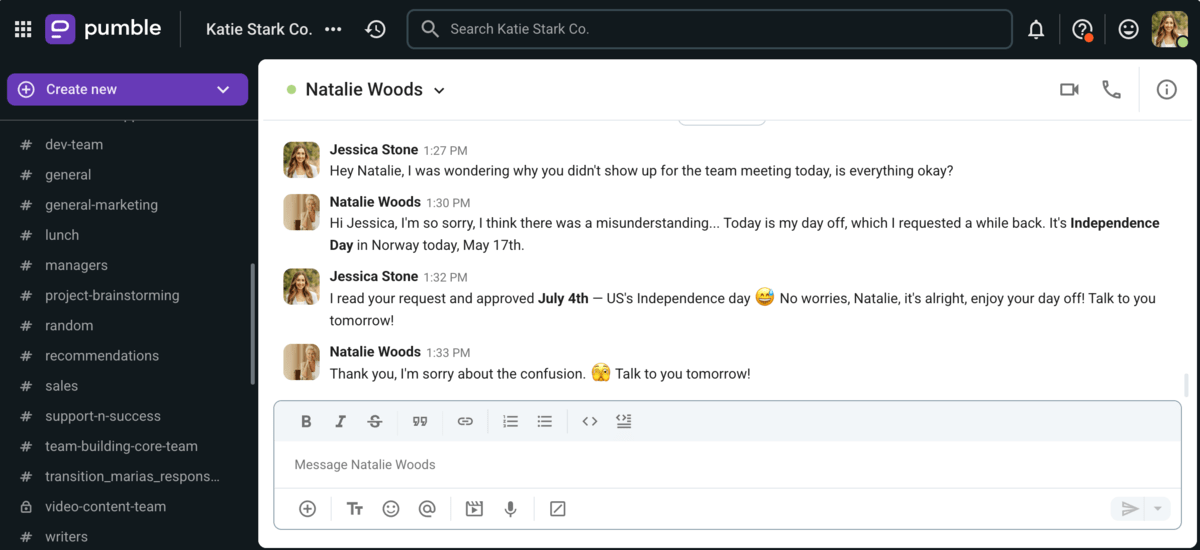
Improve communication processes with Pumble
Bridging cultural gaps is a top priority for global teams dedicated to achieving lasting success. To make sure everyone feels valued and comfortable, consider:
- Strengthening your soft skills,
- Checking in with colleagues regularly,
- Attending cross-cultural training, and
- Keeping an open mind on diverse perspectives.
Cultural barrier #4: Stereotypes
According to social psychology, a stereotype represents a “fixed, over-generalized belief about a particular group or class of people.”
In other words, we have a particular idea about how a specific group or class of people think or behave — and we assume that every member of that group or class thinks or acts similarly.
Such an approach to people who belong to different cultures builds prejudices and stops us from viewing members from other cultures as unique individuals.
Stereotypes come in different forms, but the most common ones that are disruptive to effective communication are:
- Microaggressions,
- Biases, and
- Discrimination.
One particular source of stereotypes and prejudices is ethnocentrism.
According to the classic definition by Melville J. Herskovits, ethnocentrism represents “a feeling of superiority regarding one’s own culture or way of life.”
For ethnicism to arise, there must be an “in-group” and an “out-group.”
For people with this type of outlook, it’s always “us” against “them,” which minimizes the effectiveness of many communication situations.
You can start embracing diversity and combating culture-based stereotypes by reconfiguring your perceptions.
If you’re part of a diverse workforce, go the extra mile and start a conversation with colleagues you haven’t spoken to that much.
Also, call out stereotyping when you see it, as it’s the most effective way to remove these barriers. Don’t be afraid to speak up if you notice two colleagues speaking insensitively about another teammate.
Such seemingly minor actions stack up and positively impact the development of a well-connected workforce. Remember that advocating for your coworkers is as equally important as self-advocacy at work.
🎓 Pumble Pro Tip
For a detailed look at cross-cultural communication and useful tips on how to improve it, check out this blog post:
Improve communication in distributed teams with Pumble
Cultural barrier #5: Status
The perceived importance of someone’s status can also pose a culturally-based communication barrier.
Namely, workers accustomed to workplaces where seniority and status take precedence may find it challenging to adapt to workplaces that favor a more fluid work environment with less strict rules.
But, the opposite may also be true. For example, a worker used to a workplace where teammates are encouraged to treat each other as equals might have trouble navigating a workplace with a prominent hierarchy and rules.
Status in the workplace largely depends on an organization’s structure and internal policy.
Although some roles are vital to business proceedings and grant employees a lot of power, others may not necessarily regard them as high-status roles. This disparity may lead to job dissatisfaction and, in the worst-case scenario, workplace conflicts.
So, rather than going against rules of conduct just because they are not what you’re used to, learn to adapt to changes in how workplaces function.
Remember to do your best to adapt to the new atmosphere when you go from a rule-based workplace to a more relaxed work environment or vice versa.
You can even talk about this with someone from HR to help smoothen the transition.
Language barriers to effective team communication + solutions
Language barriers represent characteristics of linguistic use that inhibit comprehension and thus prevent successful communication.

Although we associate miscommunication issues with communicators who have a different native language, they may arise even if the communicators have the same mother tongue.
Language barriers to effective communication usually result from:
- Regional accents and dialects,
- Pidgin languages,
- Jargon,
- Slang,
- Word choice, and
- Literacy and linguistic ability.
Language barrier #1: Regional accents and dialects
Team members may have the same mother tongue but also speak in different regional accents and dialects. This can cause comprehension issues, as teammates could use different pronunciations, grammar, and vocabulary.
For example, when a product team with US and UK employees organizes an on-site meeting, the organizer states they’ll hold the session on “the first floor of the building.” For the organizer and the rest of the US employees, the “first floor” is the floor at street level.
But, for teammates from the UK, the “first floor” is the floor above street level.
A simple question would clear away any second thoughts, yet many attendees feel uncomfortable and too embarrassed to ask for further clarification. Consequently, the organization encounters workflow issues, and employees waste valuable time searching for the meeting on the wrong floors.
Language barrier #2: Pidgin languages
According to the International Encyclopedia of the Social and Behavioral Sciences, pidgin languages, along with creoles, are language varieties formed from two or more languages. These new varieties have a simpler grammatical structure and narrower vocabulary than regular languages.
Additionally, they grow out of necessity when two or more groups of people speak different languages but need to communicate on a regular basis.
Pidgin languages may represent a barrier to effective communication when the standard meaning of pidgin expressions is unclear to all communicators.
For example, a common universal form of pidgin is acronyms. But, visual representations like emojis can also serve as a pictorial pidgin language.
Using acronyms and emojis in pidgin may cause a communication roadblock if some group members share a different meaning for the same emojis and acronyms.
Pidgins are legitimate language varieties, and clearing up a communication mishap is typically done quickly.
Still, using specific phrases can cause a temporary communication break.
Imagine an art director with a foreign ethnic background heading a program that organizes educational, extracurricular activities for high school and college students. Although they’ve spent most of their career in the US, they come from Papua New Guinea, so some pidgin wording occasionally finds its way into their daily communication.
When informing one of their coworkers to visit the local college for an upcoming art event, they imply visiting the “big school.” This isn’t too wrong, since many Tok Pisin speakers call universities “big schools.”
Yet, the coworker would probably be unaware of this and remain unsure whether the art director asked them to visit a high school or college.
Language barrier #3: Jargon
Jargon represents words and phrases used by a particular group of people (e.g., people in a specific industry or field of work).
Jargon is often difficult to understand for those outside of the group because it is laden with:
- Technical terms,
- Acronyms, and
- Abbreviations.
Furthermore, the overuse of jargon can lead to:
- Misinterpretation,
- Lack of understanding,
- Lack of collaboration, and
- Feelings of exclusion.
For employees working with professionals from different industries, jargon can become one of the top reasons for unclear communication.
Let’s look at one communication barrier example involving jargon.
Imagine a doctor who contacts a financial advisor about settling a patient’s medical bill slipping into their usual way of expression, mentioning terms such as “sub-therapeutic,” “agonal,” and “iatrogenic.”
On the flip side, the financial adviser might use financial terms such as “active-participant status,” “advance,” and “life annuity.” If neither can fully understand the other, what was supposed to be a 30-minute meeting could drag on for over an hour.
🎓 Pumble Pro Tip
There’s a place and time for using jargon in the workplace. To learn more about the topic, check out this blog post:
Language barrier #4: Slang
Slang is a type of informal language, and such expressions are traditionally tied to a specific region, community, or social group.
Slang consists of unconventional phrases, idioms, and vocabulary, usually absent from standardized dictionaries.
These expressions can bring people together and foster a sense of belonging.
Yet, in cases where not all parties are familiar with slang expressions, it can lead to communication rifts.
Slang varies from language to language, and when two coworkers have different mother tongues, they may be unable to grasp the meaning of each other’s regional slang.
For example, someone’s exclamation of delight “Get outta here!” could be taken at face value and understood literally, if English isn’t the recipients’ first language. This would easily result in an awkward situation where the person greeted with this expression leaves confused or even offended.
Language barrier #5: Word choice
Problems with word choice may arise if you use:
- Homophones, which are words that share the same pronunciation as other words but have different meanings. Problems with homophones may occur in verbal communication. A common homophone set includes the words there, their, and they’re.
- Homographs, which are words that share the same spelling as other words but have different pronunciations and meanings. Problems with homographs may arise in written communication. A common set of homographs consists of the past tense of the verb see (saw) and the noun saw (a tool used for cutting wood).
If you’re not careful, your word choice can sometimes give coworkers the wrong impression.
For example, a colleague might mention they’d want to “right the wrong expressions” in a report.
However, other colleagues could interpret it as wanting to “write” the wrong expressions, which would be considered spiteful, creating an instant misunderstanding out of nowhere.
Language barrier #6: Literacy and linguistic ability
Issues with literacy and linguistic ability represent the problems that might arise due to grammar and vocabulary differences.
These issues may be especially prominent if the person is trying to communicate in a language that is not their mother tongue.
But, they may also be the result of typos.
In teams whose members come from different linguistic backgrounds, things like date grammar can lead to misinterpretation, like in the following example:
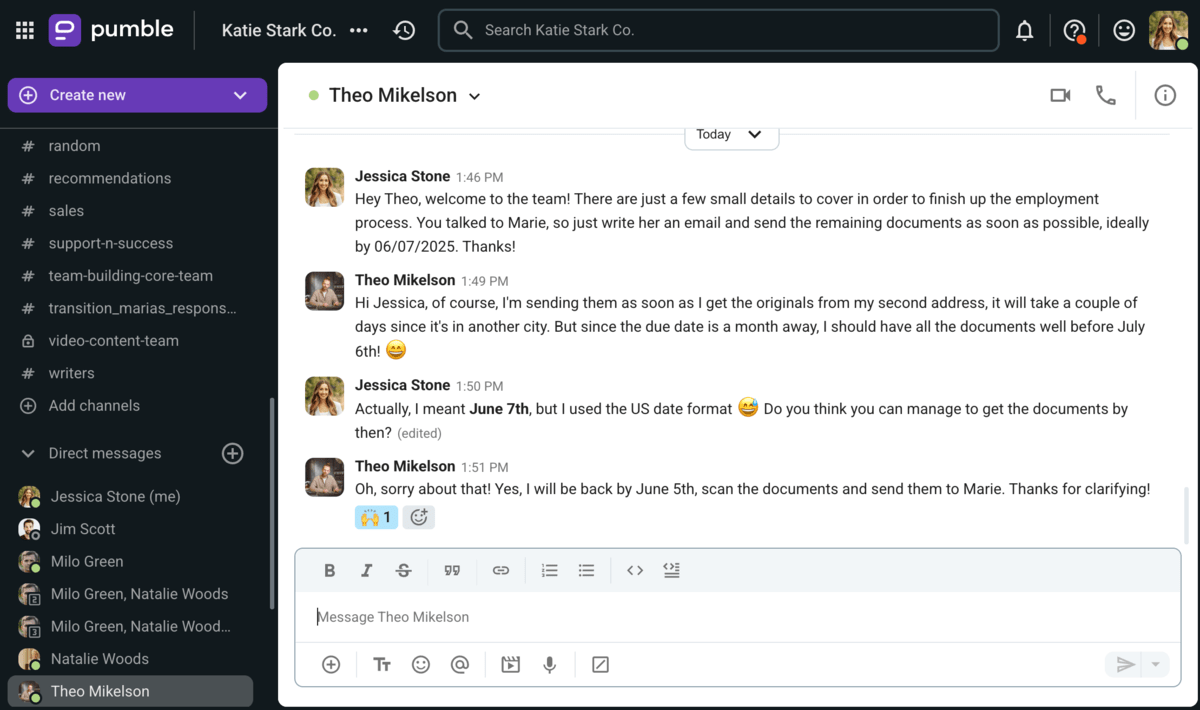
Enable smooth team communication with Pumble
Top solutions for overcoming language barriers to effective communication
Effective communication can be challenging when language barriers are present.
Here are some top solutions to help smooth out such issues:
- Keep it simple: Use straightforward and concise language a broader audience can easily understand.
- Use visuals: Incorporate diagrams, charts, or images to support written or verbal communication.
- Ask for feedback: Encourage feedback to ensure understanding and address any potential misunderstandings promptly.
- Be culturally sensitive: Recognize and respect cultural differences in communication styles, non-verbal cues, and social norms.
- Foster a supportive environment: Create an atmosphere that encourages respectful communication.
- Promote diversity: Building diverse teams with individuals from various language backgrounds can foster a collaborative environment where people learn from each other’s linguistic and cultural diversity.
Gender barriers to effective team communication
In recent years, workplace equity initiatives have helped many employees access new opportunities, regardless of gender or background.

However, these policies serve to minimize conflict and motivate employees, not resolve miscommunication troubles altogether.
Thus, we still see communication issues stemming from gender differences, which may be a result of societal values or cultural norms.
Whatever the case, one of the most common gender barriers to communication is stereotyping. Preconceived notions can significantly impact how we view people, compelling us to link particular behaviors and traits to gender differences.
These stereotypes can infringe on a person’s authenticity, preventing them from expressing themselves freely in the workplace.
Not only can gender biases contribute to a hostile work environment, but they can also create rifts between members of a team. If the tension persists, it might even have a long-lasting impact on employee mental health.
Here are some steps you can take to tackle gender-based biases and stereotypes in a professional setting:
- Educate the team: Identify and acknowledge any biases and stereotypes that may be present. Do your best to encourage open and honest discussions about these topics and ensure everyone understands how they can contribute to positive change.
- Encourage diversity: When making decisions, involve everyone in the discussion and seek feedback from all team members. These actions will help ensure that diverse perspectives are considered and valued.
- Support the HR team: When dealing with gender-based issues, it’s crucial to have a well-prepared team that will handle them respectfully and effectively. Ensure your HR team has the training and resources they need to address these problems tactfully.
Interpersonal barriers to effective communication
Interpersonal barriers to effective communication stop people from reaching their full potential by restricting communication skills.

They may manifest as an inability to listen to others attentively or maintain the attention of the people you want to communicate with.
The reason for these communication problems mainly stems from a:
- Lack of participation and
- Lack of open-mindedness.
Interpersonal barrier #1: A lack of desire to participate in communication
A crucial interpersonal barrier to effective communication is a lack of desire to participate in communication situations in the workplace.
Often, others will feel frustrated while trying to communicate with people who don’t want to interact with them.
A lot of the time, it’s not that your coworker is avoiding interacting with you. It could be just that they’re not used to the communication model the company uses.
However, this perceived lack of desire to engage in conversation can easily have dire consequences on team morale.
Here’s an example of what that might look like.
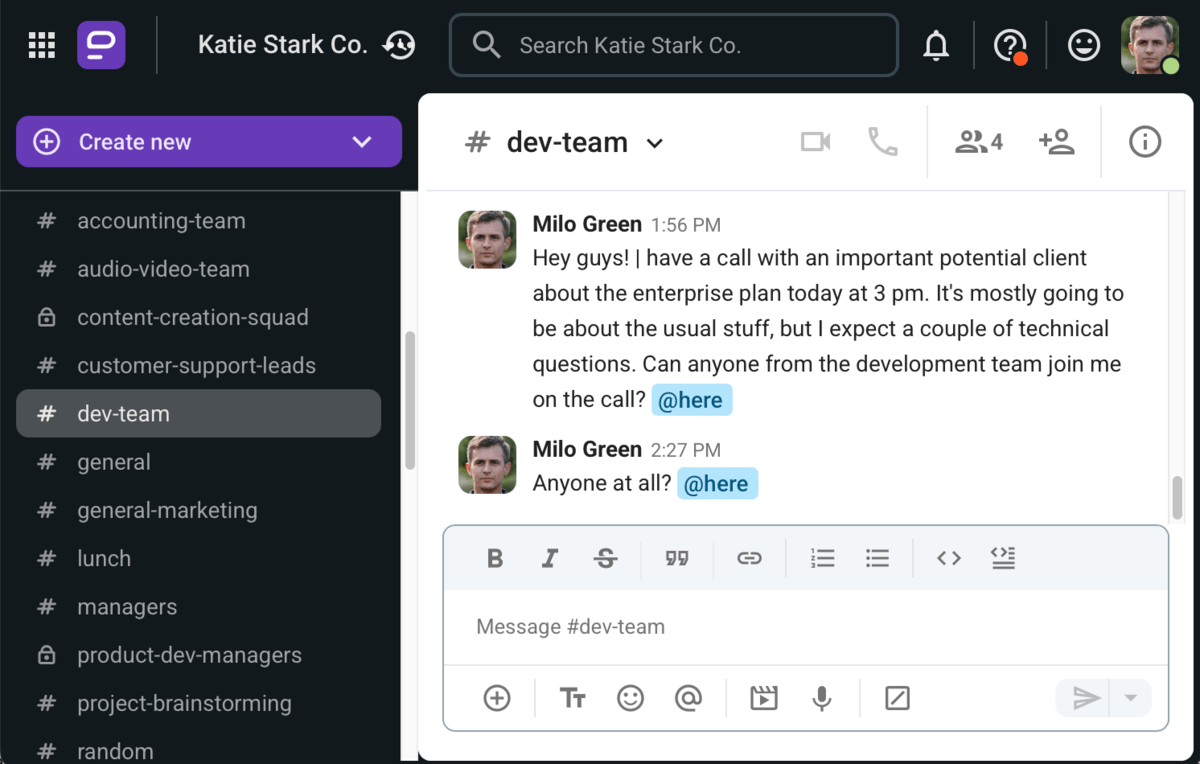
Simplify team communication with Pumble
Interpersonal barrier #2: A lack of desire to explore new concepts
Another interpersonal barrier to effective communication is a lack of desire to explore new ideas and opinions.
Closed-minded coworkers can make brainstorming sessions difficult and uncreative. Moreover, they frustrate teammates looking to dive deeper into new concepts.
No matter how much you excel at your job, being stuck in your ways doesn’t make you a good team player.
Overcoming interpersonal barriers to effective communication requires a range of tactics.
Here are 3 key strategies you can try:
- Expand your horizons: To overcome reservations towards new concepts in meetings and brainstorming sessions, venture beyond typical business communication situations. You can explore new ideas on your own by reading about relevant findings. Additionally, challenge your previous knowledge and embrace the possibility that what you once believed may not hold up today.
- Step out of your comfort zone: To combat reluctance in communication, make a conscious effort to engage more frequently. Push yourself to participate in various communication situations, whether it’s actively contributing to meetings, asking questions during onboarding, or taking the lead in resolving conflicts between colleagues. The more you engage, the more comfortable you’ll become, paving the way for future communication success.
- Offer constructive feedback: Teammates can also play a crucial role in helping others overcome communication barriers. If you notice a colleague who seems aloof or hesitant, provide them with constructive feedback. Help them improve their approach to communication, collaboration, and overall work. You can contribute to a more communicative and productive team environment by offering support and guidance.
Remember that effective communication is a valuable skill you can develop through consistent effort and a willingness to break old patterns.
By implementing these tactics, you’ll be well on your way to achieving greater success in interacting with others and fostering solid work relationships.
Organizational barriers to effective communication
Sometimes, despite the employees’ willingness to become better communicators, they run into roadblocks in the form of organizational barriers.
These issues severely limit the flow of information within an organization, preventing people from getting urgent information on time.
The primary causes of organizational barriers include:
- Strict structure and rigid hierarchy,
- Lack of transparency, and
- Lack of communication channels.
Organizational barrier #1: Strict organizational structure and rigid hierarchies
In companies where leadership is inaccessible, meaningful interactions may become few and far between. Consequently, managers are urgently looking for the information their teams desperately need to complete their work.
This may work as a short-term solution, but eventually, it creates a mistrust of leadership and a culture where employees are reluctant to speak up.
The absence of open dialogue means the employee input gets lost because workers believe leadership isn’t interested in hearing them out. Besides, in such environments, employees often feel ill-equipped to deal with the possible repercussions.
If your organization is facing communication issues due to a strict internal structure, you can improve operations through:
- Flattening hierarchies: Try flattening internal hierarchies by moving part of the decision-making process to include more employees. Not only does this engender inclusivity, but it also fosters a feeling of professional autonomy.
- Promoting cross-level collaboration: When employees from different teams and hierarchical levels work together to achieve a shared goal, they develop stronger relationships. Consequently, they learn about each other’s abilities, build greater trust, and acquire new perspectives. All of this contributes to greater job satisfaction and enhanced productivity levels.
- Developing better feedback channels: Quarterly performance assessments, one-on-one meetings, and employee surveys are just a few possible ways you can take note of employee feedback. Workers who readily express their concerns and thoughts aid you in creating a positive professional environment.
Organizational barrier #2: Lack of transparency
Transparency is one of the key ingredients for running a successful business.
Improving upward communication or resolving problems with lateral communication is impossible without transparency.
Organizations that put a lot of value on transparency encourage employees to exchange information across different levels, which in turn makes them more:
- Trustworthy and
- Collaborative.
Yet, the 2023 Edelman Trust Barometer survey shows that most workers lack faith in their employers. Furthermore, the survey highlighted that 1 in 3 respondents stated they didn’t trust their employer.
According to Pumble’s Employee Engagement Statistics for 2025, only 23% of employees said they firmly trust their leadership. Furthermore, 1 in 3 employees stated they didn’t believe their leadership communicates a clear vision for the future.
The absence of transparent communication can have long-term consequences on business operations, including:
- Lower engagement and motivation levels,
- Employees who are reluctant to self-advocate at work, and
- Higher turnover rates.
Without transparency, employees have limited access to vital resources and expected outcomes, making it challenging to develop a feasible work strategy.
Fostering a culture of transparency takes time and effort, and there are several practices you can implement to achieve this goal.
Some of the ways you can do so are by:
- Providing adequate training and education: Communication is a skill, and not every professional starts out as an effective communicator. But, through workshops, seminars, and team-building activities, they can acquire the tools and skills that will allow them to excel in transparent communication.
- Being open about decision-making processes and strategies: Make sure that employees fully understand the organization’s core values and principles. Whenever there is a new initiative or practice, a company-wide meeting can help prevent teams from feeling like they’re left out of the decision-making process.
- Being clear about performance assessments: Taking employees through every step of their performance review is crucial to maintaining transparent communication. It ensures workers understand how and why their achievements contribute to the bigger picture and helps them better relate to strategic goals.
Organizational barrier #3: Lack of communication channels
Employee effort goes to waste if communication channels are insufficient or lacking.
For example, knowledge sharing is quicker and easier for teams that rely on video conferencing. However, when the organization adamantly insists on using an unsuitable communication channel, much of the information can get lost in the shuffle.
As a result, we see:
- Missed opportunities,
- Lack of timely feedback,
- Mistakes and miscommunication, and
- Dissatisfied customers.
Communicate effectively with Pumble
🎓 Pumble Pro Tip
For a deep dive into communication channels, check out this thorough guide:
Without clear and well-established communication pathways, no team can thrive for long, and coworkers feel isolated and disconnected, and information could take way too long to reach its destination, or multiple destinations.
To prevent long-term communication issues that stem from lack of communication channels, try:
- Implementing new communication channels: User-friendly and intuitive team communication apps can unite all employees. Whether they prefer to come into the office or work remotely, they’ll know the person they need to contact is just a few clicks away. Also, project management tools can further optimize workflows by providing an overview of urgent and long-term tasks and goals.
- Holding regular meetings: In teams whose workflow involves dynamic and complex tasks, weekly team meetings and occasional one-on-one meetings prevent feelings of loneliness and the development of team silos.
- Providing comprehensive communication training: Workshops on active listening, communication planning, and business communication can help employees tackle different situations during their workday.
Overcoming communication barriers with Pumble
Even though several types of communication barriers may prevent us from reaching our goals, there are ways to alleviate these issues.
Regardless of the type of misunderstanding you might have, all potential problems can quickly be addressed and corrected with a versatile team collaboration app like Pumble.
Some of the features that can speed up communication and resolve misunderstandings include:
- Channels — for important group discussions and sending information to multiple people with ease,
- Threads — for following various important topics in a channel with many members,
- Video conferencing — for clarifying any misunderstandings, face-to-face,
- Screen sharing — for sharing required visual materials during video calls,
- Voice calls — for any necessary additional verbal explanations.
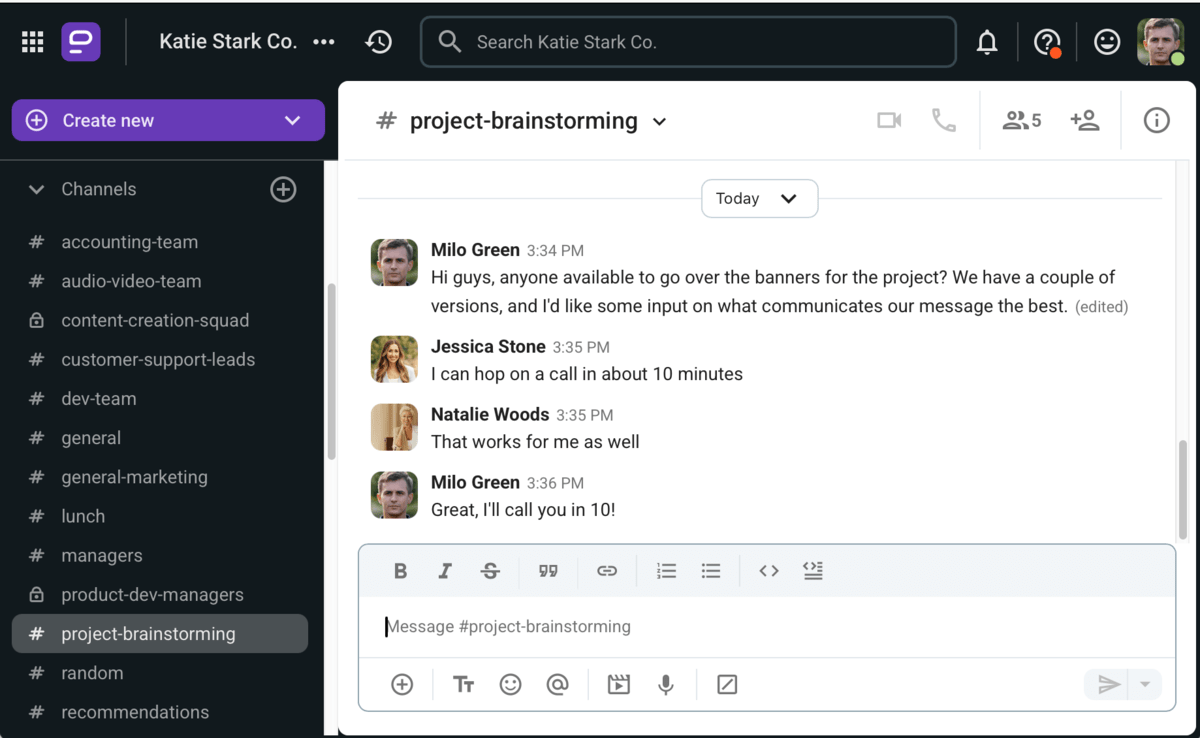
With these, and many more features, you can organize your team and address any potential issues quickly, dissolving any tension that can stem from communication barriers.
Get ready to improve team communication, notify team members, and clarify information quickly — try Pumble by CAKE.com today!
How we reviewed this post: Our writers & editors monitor the posts and update them when new information becomes available, to keep them fresh and relevant.


